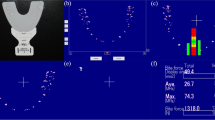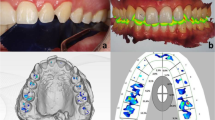Abstract
Objectives
The aim of this study is to compare the sensitivity of T-Scan digital occlusal analysis system and the occlusal analysis mode of the CEREC Omnicam system, which is mainly used for design/production, using the data recorded at the maximum intercuspal position.
Materials and methods
Occlusal recordings were obtained from healthy 20 females and 20 males aged 18–25 at the maximum intercuspal position. Records were saved as.jpeg format and transferred to Adobe Photoshop CS6 program. Blue, green, and red colors (shown by the same color codes in both systems) representing light, intense, and tight contacts, respectively, were evaluated in terms of the pixel counts. For statistical comparison, the differences between the systems independent sample T test and, between the genders, one sample T test were used (α = 0.05).
Results
The total numbers of pixels of all colors which are evaluated with T-Scan and CEREC Omnicam in females were 31,296.6 and 15,745, respectively, and in males 39,812.3 and 17,462, respectively. In both systems, the blue contact area is the most seen. For all colors tested, T-Scan recorded more contact than those of CEREC Omnicam in both genders and statistically significant difference was found between two systems for all colors. In both systems, recorded contacts are significantly higher in men than in women. Compared with women, 27% more contact area was recorded in men with T-Scan and 11% more with CEREC Omnicam was obtained.
Conclusions
While T-Scan was found sensitive even in the diagnosis of light contacts, the CEREC Omnicam was found sensitive only in the diagnosis of tight contacts.
Clinical relevance
Although both T-Scan and CEREC Omnicam are effective in occlusal analysis, T-Scan’s sensitivity was found to be higher.
Trial registration
ClinicalTrials.gov identifier: NCT04798729






Similar content being viewed by others
References
Ferro KJ, Morgano SM, Driscoll CF, Freilich MA, Guckes AD, Knoernschild KL, McGarry TJ, Twain M (2017) The glossary of prosthodontic terms. J Prosthet Dent 117(5):1–105
Korioth T (1990) Number and location of occlusal contacts in intercuspal position. J Prosthet Dent 64(2):206–210
Pyakurel U, Long H, Jian F, Sun J, Zhu Y, Jha H, Lai W (2013) Mechanism, accuracy and application of T-Scan system in dentistry- a review. J Nepal Dent Assoc 13(1):52–56
Koc D, Dogan A, Bek B (2010) Bite force and influential factors on bite force measurements: a literature review. Eur J Dent 4(2):223–232
Filtchev AD, Kalachev YS (2008) Phenomenon of domination of the strongest contacts in centric occlusion. Quintessence Int 39(3):99–106
Palinkas M, Nassar MSP, Cecílio FA, Siéssere S, Semprini M, Machado-de-Sousa JP, Hallak JEC, Regalo SCH (2010) Age and gender influence on maximal bite force and masticatory muscles thickness. Arch Oral Biol 55(10):797–802
Garner L, Kotwal N (1973) Correlation study of incisive biting forces with age, sex, and anterior occlusion. J Dent Res 52(4):698–702
Bozhkova TP (2016) The T-SCAN system in evaluating occlusal contacts. Folia Med 58(2):122–130
Okeson JP (2008) Management of Temporomandibular Disorders and Occlusion. Springer, St. Louis
Rosenstiel SF, Land MF, Fujimoto J (2006) Contemporary Fixed Prosthodontics, 5th edn. Elsevier Health Sciences, China
Jambhekar S, Kheur M, Kothavade M, Dugal R (2010) Occlusion and occlusal considerations in implantology. J Indian Dent Assoc 2(1):125–130
Türp JC, Greene C, Strub J (2008) Dental occlusion: a critical reflection on past, present and future concepts. J Oral Rehabil 35(6):446–453
Plesh O, Stohler C (1992) Prosthetic rehabilitation in temporomandibular disorder and orofacial pain patients. Clinical problem solving. Dental Clinics of North America 36(3):581–589
Bell YL, Jämsä T, Korri S, Niemi PM, Alanen P (2002) Effect of artificial occlusal interferences depends on previous experience of temporomandibular disorders. Acta Odontol Scand 60(4):219–222
Dawson PE (2007) Functional Occlusion: From TMJ to Smile Design, 1st edn. Mosby, St. Louis
McNeill C (1997) Science and Practice of Occlusion. Quintessence Publishing, Chicago
Qadeer S, Kerstein R, Kim RJY, Huh J-B, Shin S-W (2012) Relationship between articulation paper mark size and percentage of force measured with computerized occlusal analysis. The Journal of Advanced Prosthodontics 4(1):7–12
Brizuela-Velasco A, Álvarez-Arenal Á, Ellakuria-Echevarria J, del Río-Highsmith J, Santamaría-Arrieta G, Martín-Bianco N (2015) Influence of articulating paper thickness on occlusal contacts registration: a preliminary Report. Int J Prosthodont 28(4):360–362
Saad MN, Weiner G, Ehrenberg D, Weiner S (2008) Effects of load and indicator type upon occlusal contact markings. J Biomed Mater Res B Appl Biomater 85(1):18–22
Carey JP, Craig M, Kerstein RB, Radke J (2007) Determining a relationship between applied occlusal load and articulating paper mark area. Open Dent J 1:1–7
Majithia I, Arora V, Kumar SA, Saxena V, Mittal M (2015) Comparison of articulating paper markings and T-Scan III recordings to evaluate occlusal force in normal and rehabilitated maxillofacial trauma patients. Med J Armed Forces India 71:382–388
Bulycheva D, Bulycheva, YA (2015) Applying the diagnostic scanner "T-Scan" to analyze the occlusion relationships of the dentitions in the prosthodontist’s practice. In International Scientific and Practical Conference World Science 2(4):13–14
Saraçoǧlu A, Özpinar B (2002) In vivo and in vitro evaluation of occlusal indicator sensitivity. J Prosthet Dent 88(5):522–526
Kerstein RB, Radke J (2014) Clinician accuracy when subjectively interpreting articulating paper markings. CRANIO® 32(1):13–23
Abdulateef S (2018) In-vivo comparison of digital and conventional inter-occlusal records, in Craniofacial Science. University of British Columbia, Vancouver
Arslan Y, Karakoca Nemli S, Bankoğlu Güngör M, Tamam E, Yılmaz H (2015) Evaluation of biogeneric design techniques with CEREC CAD/CAM system. J Adv Prosthodont 7(6):431–436
Davies S, Gray R (2001) Occlusion: What is occlusion? Br Dent J 191(5):235–245
Becker CM, Kaiser DA (1993) Evolution of occlusion and occlusal instruments. J Prosthodont 2(1):33–43
Serra C, Manns A (2013) Bite force measurements with hard and soft bite surfaces. J Oral Rehabil 40(8):563–568
Testa M, Di Marco A, Pertusio R, Van Roy P, Cattrysse E, Roatta S (2016) A validation study of a new instrument for low cost bite force measurement. J Electromyogr Kinesiol 30:243–248
Coelho MF, das Neves Cavalcanti B, Neves ACC, Jóias RP, de Mello Rode S (2015) Influence of dental chair backrest inclination on the registration of the mandibular position. J Prosthet Dent 114(5):693–695
Haralur SB, Al-Gadhaan S, Al-Qahtani A, Mossa A, Al-Shehri W, Addas M (2014) Influence of functional head postures on the dynamic functional occlusal parameters. Ann Med Health Sci Res 4(4):562–566
Jain R, Jabbal R, Bindra S, Aggarwal S, Jain R (2015) T-Scan a digital pathway to occlusal perfection: A review. Ann Prosthodont Restor Dent 1(1):32–35
Toledo MFDSM, Jóias RP, Marques-Iasi YS, Neves ACC, Rode, S.d.M. (2014) Thickness and marking quality of different occlusal contact registration strips. J Appl Oral Sci 22(6):516–521
Schelb E, Kaiser DA, Brukl CE (1985) Thickness and marking characteristics of occlusal registration strips. J Prosthet Dent 54(1):122–126
Forrester SE, Presswood RG, Toy AC, Pain GT (2011) Occlusal measurement method can affect SEMG activity during occlusion. J Oral Rehabil 38(9):655–660
T-SCAN® 9.1 User Manual (2015) Boston
Sarwar MS, Dobashi Y, Preston C, Wyss JK, Mirabbasi S, Madden JDW (2017) Bend, stretch, and touch: Locating a finger on an actively deformed transparent sensor array. Sci Adv 3(3):1–8
Koos B, Godt A, Schille C, Göz G (2010) Precision of an instrumentation-based method of analyzing occlusion and its resulting distribution of forces in the dental arch. J Orofac Orthop 71(6):403–410
Bakke M (2006) Bite force and occlusion. Seminars in Orthodontics 12(2):120–126
Shinogaya T, Bakke M, Thomsen C, Vilmann A, Matsumoto M (2000) Bite force and occlusal load in healthy young subjects–a methodological study. Eur J Prosthodont Restor Dent 8(1):11–15
Braun S, Hnat WP, Freudenthaler JW, Marcotte MR, Hönigle K, Johnson BE (1996) A study of maximum bite force during growth and development. Angle Orthod 66(4):261–264
Solaberrieta E, Etxaniz O, Otegi JR, Brizuela A, Pradies G (2017) Customized procedure to display T-Scan occlusal contacts. J Prosthet Dent 117(1):18–21
Funding
The study was supported by Gazi University Scientific Research Projects Unit (no: 03/2018–22).
Author information
Authors and Affiliations
Corresponding author
Ethics declarations
Ethics approval
All procedures performed in studies involving human participants were in accordance with the ethical standards of the institutional and/or national research committee and with the 1964 Helsinki declaration and its later amendments or comparable ethical standards.
Informed consent
Written informed consent was obtained from all the study participants.
Conflict of interest
The authors declare no competing interests.
Additional information
Publisher's note
Springer Nature remains neutral with regard to jurisdictional claims in published maps and institutional affiliations.
Rights and permissions
About this article
Cite this article
Bostancıoğlu, S.E., Toğay, A. & Tamam, E. Comparison of two different digital occlusal analysis methods. Clin Oral Invest 26, 2095–2109 (2022). https://doi.org/10.1007/s00784-021-04191-1
Received:
Accepted:
Published:
Issue Date:
DOI: https://doi.org/10.1007/s00784-021-04191-1




